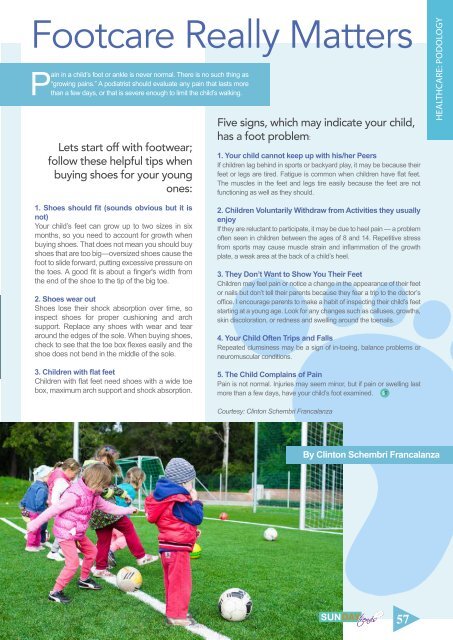You also want an ePaper? Increase the reach of your titles
YUMPU automatically turns print PDFs into web optimized ePapers that Google loves.
Footcare Really Matters<br />
Pain in a child’s foot or ankle is never normal. There is no such thing as<br />
“growing pains.” A podiatrist should evaluate any pain that lasts more<br />
than a few days, or that is severe enough to limit the child’s walking.<br />
Lets start off with footwear;<br />
follow these helpful tips when<br />
buying shoes for your young<br />
ones:<br />
Five signs, which may indicate your child,<br />
has a foot problem:<br />
1. Your child cannot keep up with his/her Peers<br />
If children lag behind in sports or backyard play, it may be because their<br />
feet or legs are tired. Fatigue is common when children have flat feet.<br />
The muscles in the feet and legs tire easily because the feet are not<br />
functioning as well as they should.<br />
HEALTHCARE: PODOLOGY<br />
1. Shoes should fit (sounds obvious but it is<br />
not)<br />
Your child’s feet can grow up to two sizes in six<br />
months, so you need to account for growth when<br />
buying shoes. That does not mean you should buy<br />
shoes that are too big—oversized shoes cause the<br />
foot to slide forward, putting excessive pressure on<br />
the toes. A good fit is about a finger's width from<br />
the end of the shoe to the tip of the big toe.<br />
2. Shoes wear out<br />
Shoes lose their shock absorption over time, so<br />
inspect shoes for proper cushioning and arch<br />
support. Replace any shoes with wear and tear<br />
around the edges of the sole. When buying shoes,<br />
check to see that the toe box flexes easily and the<br />
shoe does not bend in the middle of the sole.<br />
3. Children with flat feet<br />
Children with flat feet need shoes with a wide toe<br />
box, maximum arch support and shock absorption.<br />
2. Children Voluntarily Withdraw from Activities they usually<br />
enjoy<br />
If they are reluctant to participate, it may be due to heel pain — a problem<br />
often seen in children between the ages of 8 and 14. Repetitive stress<br />
from sports may cause muscle strain and inflammation of the growth<br />
plate, a weak area at the back of a child’s heel.<br />
3. They Don’t Want to Show You Their Feet<br />
Children may feel pain or notice a change in the appearance of their feet<br />
or nails but don’t tell their parents because they fear a trip to the doctor’s<br />
office. I encourage parents to make a habit of inspecting their child’s feet<br />
starting at a young age. Look for any changes such as calluses, growths,<br />
skin discoloration, or redness and swelling around the toenails.<br />
4. Your Child Often Trips and Falls<br />
Repeated clumsiness may be a sign of in-toeing, balance problems or<br />
neuromuscular conditions.<br />
5. The Child Complains of Pain<br />
Pain is not normal. Injuries may seem minor, but if pain or swelling last<br />
more than a few days, have your child’s foot examined. <strong>ST</strong><br />
Courtesy: Clinton Schembri Francalanza<br />
By Clinton Schembri Francalanza<br />
57

















